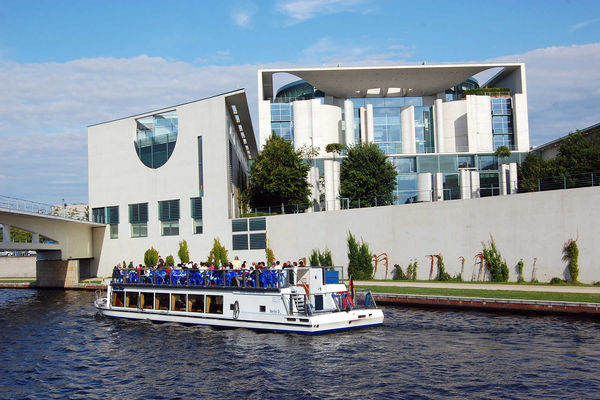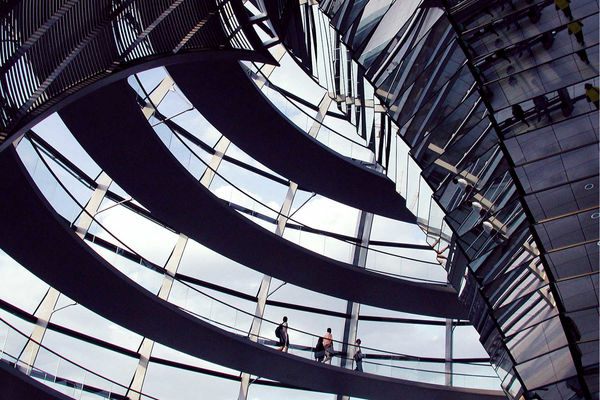Berlin in the 21st Century
By Rick Steves

More than any other place in Europe, Berlin is a work in progress. Over the last several decades, ripped-up tracks and a canopy of cranes have signaled its rebirth as a great city. If you haven't been here lately, you won't recognize the place.
In the early 1900s, Berlin was an avant-garde cultural capital — think cabarets and Marlene Dietrich. But then came Hitler. After a difficult 20th century, today's Berlin is proudly stepping up to retake its place as Europe's powerhouse. Since German reunification in 1990, the city has gone on a building frenzy, wasting no time in refashioning itself. When the Wall fell, East Berlin was a decrepit wasteland, but these days, the vibrant pulse of the city is steadily drifting eastward.
The city center itself is blossoming. It's worth taking a boat tour or pedaling a rental bike along the Spree River just for the chance to glide by all the sleek new governmental architecture that lines its banks. You'll see colossal buildings like the federal Chancellery — Germany's grandiose answer to our White House, complete with its own river bridge and a helicopter pad. While Prussian rulers once built their buildings right up to the river's edge, Berlin today seems determined to make its riverbanks a delightful park. New buildings are set back, beachy cafés come with summery lounge chairs, and the river — once hung with metal nets and barbed wire to keep people from crossing it to freedom — now makes you want to walk a dog and hug someone.
One of the most ambitious urban renewal projects is taking place in the cultural park of Museum Island, which sits right in the middle of the Spree. The 19th-century Prussian king Friedrich Wilhelm IV imagined the island as a place of art and learning, and began constructing what would eventually become five separate museums. But WWII bombs and communist-era neglect left the buildings and their collections in shambles. Now, each of these world-class galleries (proud home to the Greek Pergamon Altar and the exquisite Queen Nefertiti bust) is being renovated in turn. When the dust finally settles, a grand visitors center will link the museums.
Old spaces are being reimagined for cultural purposes throughout the city. The Humboldt-Forum Berliner Schloss, a huge public venue, is rising where a Hohenzollern palace once stood. Shops, galleries, and concert halls will operate behind a facade built in precise imitation of the Baroque original. The Prussian home of the German History Museum (a former arsenal) has a strikingly modern all-glass annex. The stately old red-brick Imperial Post Office now hosts an innovative avant-garde photography gallery.
A fitting symbol for the new Berlin is its rebuilt Reichstag — this country's historic parliament building and the symbolic heart of German democracy. When inaugurated in the 1890s, the emperor dismissed the parliament building as a "house for chatting." At the end of World War I, the German Republic was proclaimed from here. Then, in 1933, a mysterious fire gutted the building. It stood mostly empty through the Cold War.
Now, with the parliament back in Berlin, the Reichstag welcomes the public (or at least those who've made advance reservations). It is a great example of contemporary architecture that is both dramatic and meaningful within its environment. The building combines old and new, as does the reunited Berlin. While the original cupola that capped the building was stone and steel, the present one is glass. A walkway inside winds all the way to the top, and tourists like the view out. But for Germans, it's the view in that matters — keeping a close eye on their government at work.
Berlin can sometimes feel more imposing than charming. Along with huge museums and towering architecture, its sprawling apartment complexes are immense, with courtyard after courtyard retreating in from the street front. Traditionally, the poorer you were, the deeper into the complex you lived.
But with its rebirth, the city's prewar historic center is filling up with new residents and revitalized buildings. Apartment blocks are livelier than ever. Hackeschen Höfe — with eight courtyards spilling through a wonderfully restored 1907 Art Nouveau building — is just one of the many complexes now home to sought-after residences, stylish restaurants, and trendy art galleries. These courtyards are a wonderful example of how to make huge city blocks livable, and they also serve a useful lesson for visitors: Much of Berlin's charm hides off the street front.
The attention given to Berlin's 20th-century history — Hitler, communism, the Wall — is intriguing for many. But for young Berliners, that's ancient history — and a visitor to this moving target of a city will see why. Today's Berlin is a nonstop festival of style, substance, and constant change.

